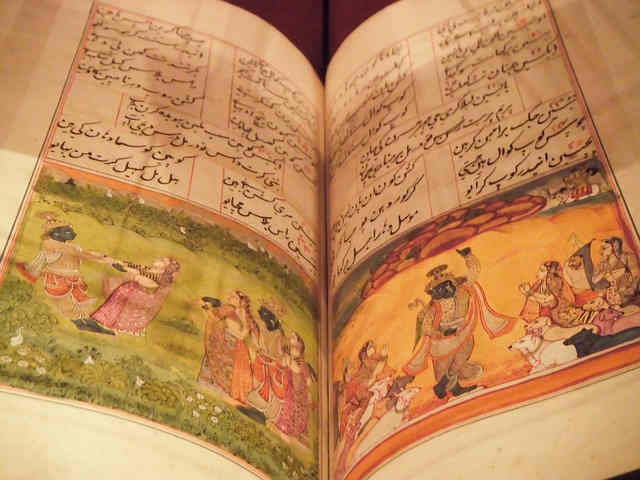What is Bhakti Yoga? In this video and article, we’ll explore the meaning of Bhakti and look at its history of “egalitarian” spirituality plus the history of the Bhakti movement in general.
A simple definition of Bhakti Yoga floating around is “the yoga of devotion”.
It is the practice of having a personal relationship with the Supreme Absolute (or God, the Beloved, the True Self, the Universe, Higher Power, the Big Cheese, Spirit, the One Love, etc).
Bhakti is Universal

The term Bhakti Yoga is normally used within an Indian context, though this is changing as the world becomes smaller and people realize their similarities.
Spearhead singer Michael Franti reminds us, “God is too big for just one religion.”
Let’s remember that the meaning of the word “yoga” has nothing to do with fitness programs. It means union.
This union can mean the union of mind and body. It can also mean the union of the many parts of the brain through spiritual practice. Ultimately, it is the union of the individual soul with God. It’s a universal concept that transcends all religions and that exists in all of them.
The term “yoga” usually implies realization of the reality behind the above concepts through direct experience via some kind of practice. It’s definitely not blind faith unless that faith can somehow become a practical tool that brings true realization and the destruction of blind faith.
There Are Many Ways to Practice Bhakti

Bhakti Yoga practices vary. One of the more popular forms of Bhakti Yoga is singing to God. This can be in a particular form such as Shiva or the goddess Kali. In Indian traditions, the singing is often performed in the ancient Sanskrit language.
Bhaktas in the Christian religion often rejoice in hymns. Hymns are a beautiful way to express devotion. It is the part of the service that many look forward to. That’s because Bhakti is practical and brings you closer to that Supreme Love than any didactic teaching or sermon.
The term Bhakti Yoga has been popularized in the west by the proliferation of kirtan, devotional singing in groups. Rock stars like Krishna Das, Jai Uttal, and Deva Premal have created a musical niche from singing to all the faces of the divine in the Sanskrit language.
Most cities in the west have regular kirtan events at yoga studios and churches. Because of these musical occurrences, western yoga is beginning to regain its spiritual qualities.
Other Bhakti practices include offerings such as offering your food to the Beloved before eating, listening to or reading scripture, worshiping an image of God in some form, prayer and homage, reading or listening to ecstatic poetry and surrendering yourself to the experience of the absolute.
The personal relationship element of Bhakti varies. The practitioner can think of the Absolute as a lover, a mother, a father, a friend or a master. The expression depends on the individual.
The 4 Fundamental Forms of God

There are four basic forms of the Supreme Absolute that Bhakti Yogis worship.
1. God in the form of various gods and goddesses. The mystics are quick to say that these are just “faces” of God. They are symbols of characteristics of the Absolute that our affections can be tangibly directed to. With devotion, the “bhakta” gradually merges with the Reality behind the symbolic object of affection.
Christians often use this form of Bhakti through the forms of Jesus and the bearded Father. They’re typically thought of as white boys, but it works.
2. God in the form of guru. A guru is someone who has ceased the grasping of ego and has realized enlightenment. The word does not mean “spiritual teacher” or just anyone who claims to be a guru. Guru is actually another word for saint.
Some people who find such a person practice Bhakti with the guru. Just as with the worship of deities, students often find that the guru is not God either. Then the “form” gradually becomes less and less important.
3. God as a formless absolute being. This is actually closer to reality than the other approaches, but it’s not as tangible. It’s a very difficult approach to explain. Some will think of it as the deep stillness of spirit out of which comes all form and movement.
4. God as your true highest Self (Supersoul). There is so much gobbledygook about this, but there is truth behind it all. I won’t add more gobbledygook to the conversation, but I can say this. Gradual realization through devotion and meditation takes this out of the conceptual realm and into reality.
Bhakti Yoga in the Bhagavad Gita

The Bhagavad Gita is one of the main works that is widely credited for inspiring the Bhakti movements in India. Scholars place its genesis between the 2nd and 5th centuries A.D. Like many other scriptures, it evolved through oral tradition.
The Bhagavad Gita defines Bhakti Yoga in chapter twelve and, arguably, in chapters seven through twelve.
Krishna is the chariot driver in the Gita. Throughout the whole story, he is talking to Arjuna, the passenger. Krishna symbolizes God and Arjuna symbolizes the devotee.
Krishna spoke about what people do to become close to Him. Those who have their minds fixed on God come up the most. Absolute absorption in loving thoughts of God bring realization and deepen real absorption.
Krishna also mentions surrender of self. This is a tough one to explain, but loving absorption helps you to know what this means experientially. It is about going inward, listening to spirit and surrendering to the result.
“Abandon all varieties of religion and just surrender unto Me. I shall deliver you from all sinful reactions. Do not fear.” -Krishna
In the Bhakti Yoga section of the Gita, Krishna also describes his most advanced devotees, the ones who are closest. They “pray without ceasing” and fully understand what that term means.
They renounce the fruit of their actions (Karma Yoga) and serve the Beloved. Insults and praise mean nothing to them. They are imperturbable to hot and cold, pleasure and pain. They love all people and serve all people.
Bhakti History: How Did it Spread Through India & the World?

As mentioned previously, one of the main inspirations of the Bhakti movement was the Bhagavad Gita, and this work originated in one of the early few centuries A.D.
There were other scriptures, written at various points, that emphasized Bhakti, but the Gita’s effects were revolutionary.
This work followed thousands of years of Vedic scriptures and traditions and their elaborate rituals. The Gita simplified the science of God Realization by making it more accessible to everyone throughout the entire caste system.
Does this seem familiar to you? Remember pre-Christ Judaism and “the laws”? People could not mention God. God was something to be feared. A personal relationship with the divine was unheard of.
Then, Yeshua (Jesus) came along and said, “No, no, no, you goof offs. You have it all wrong. Just think of God as a loving father and develop a relationship with Him. Call Him Abba. It’s all about love, man.”
That was a paraphrase, by the way.
The Bhagavad Gita did not go into too much detail about particular methods of Bhakti. Later generations turned that into a science.
This scripture, like Jesus’ ministry, revolutionized the social landscape. It wasn’t just the priest class who were entitled to the holy practices.
Women and people from all casts gradually realized that they had access to this higher dimension of life. There were eras when this upset the established order.
Bhakti Yoga became very popular in the seventh century. The egalitarian nature of this movement upset the priestly caste initially, but then it became so popular that it was considered normal in India.
There was another large surge in the Bhakti movement in the middle ages (14th – 17th centuries). Ecstatic poet Kabir was one of the more notable characters from this era. During this time there was a corresponding surge of devotional literature, song and poetry.
Just like in the seventh century, the general attitude during this wave was that spirituality was simple and had nothing to do with caste. It was available to the masses. During a time when certain castes claimed a monopoly on salvation, the Bhaktas claimed “the kingdom of heaven is at hand.”
Some of the trends during this Bhakti era even tended toward taking Sanskrit out of Bhakti and keeping it in the languages that ordinary people spoke.
Bhakti Yoga never died as a movement. Now, it’s a mighty empire that is spreading around the world.
The Krishna Consciousness movement became a household name in the 1960’s and 70’s. George Harrison released “My Sweet Lord” in 1970.
Now, we have Krishna Das singing at the Grammys pre-show.
And, of course, we have many decades of gospel music behind us and centuries worth of hymns.
What do you do when a blog post you wrote surpasses about 1400 words or so, and you have no exit plan? I know what I’ll do.
Share Your Insights or Questions
What are your experiences with Bhakti Yoga? Do you have insights to share? Share them in a comment below.
Is anything unclear/wrong/etc? Ask a question or chime in with some input below.
Tom Von Deck is a meditation trainer, speaker, and speaker. Tom specializes in making meditation much much easier for busy and non-busy people from all backgrounds and paths. He is the Mackdaddy of The Deeper Meditation Video Zone and DeeperMeditation.net.



5 comments
FirstDacia
I see you don’t monetize your website, don’t waste your
traffic, you can earn additional bucks every month because you’ve got high quality content.
If you want to know how to make extra $$$, search for: Mrdalekjd methods for $$$
Lama Surya Das
Bhakti Yoga is considered the easiest yogic path to master and the most direct method to experience the unity of mind, body and spirit. Bhakti yoga is a way of transforming your emotion from negativity to pleasantness.Just see, people who have fallen in love do not care about what is happening in the world.
Bruce
I see a lot of interesting content on your page. You have to spend
a lot of time writing, i know how to save you a lot of work, there is a
tool that creates unique, SEO friendly posts in couple of minutes, just type
in google – laranita’s free content source